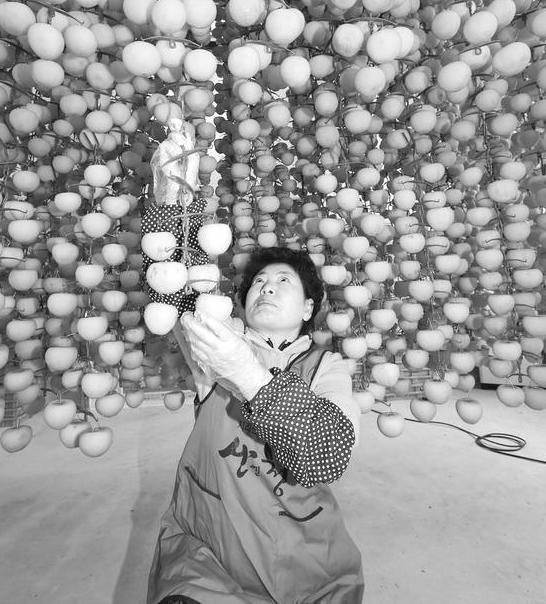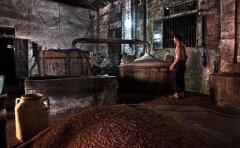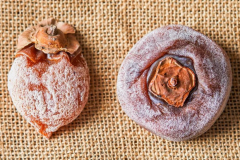The origin story of Korean persimmon! Flavor characteristics of Korean Persimmon and Fuping Persimmon
Whether Hakkas or Koreans, persimmons are very rough, but ripe fruits are not easy to preserve, so persimmons emerge as the times require.
The fiery red persimmon hanging all over the branches is a common autumn scenery in Korea, and persimmon is also a cheaper fruit in Korea. Fresh ripe persimmons look good, but they are difficult to keep for a long time. And dried into persimmons, it has become a favorite traditional delicacy in South Korea.

Korean aunt is drying persimmons.
Unlike domestic flat persimmons, Korean persimmons are mostly oblong hanging persimmons, literally called "string persimmons", which are made of persimmons strung together with bamboo sticks or string and dried through a variety of processes. Flat and round persimmons are called squatting persimmons. Because persimmon trees can be seen everywhere, persimmon is cheap. In ancient times, persimmon with high sweetness was one of the important sources of sugar, so persimmon was a very popular food in ancient times, mainly eaten at important festivals, sacrifices, weddings and other occasions.
On these important occasions, virtuous housewives will stuff walnuts or pine nuts into persimmon cakes to make snacks and put them in the shape of flowers on the offering table. After letting the ancestors "taste", these tribute became the delicacy of the children, the aroma of walnut and pine nut neutralized the sweetness of persimmon, and the soft waxy persimmon added a delicate taste.
The delicacy of persimmons can also be read in Korean fairy tales. One night, the tiger came to the village and overheard the mother of a family coaxing her child. Mother said, "here comes the tiger. Don't cry." But the baby continued to cry. Mother can not take out persimmon "inducement", "persimmon is coming, don't cry." The child was gluttonous and stopped crying. The tiger outside was surprised, "it seems that persimmon is more terrible than a tiger. I have to run quickly."
In history, persimmon has become the prop of the court struggle. According to the Records of the Korean Dynasty, the king of the Korean dynasty hated Princess Yoon, so he abandoned persimmons with arsenic as common people and finally died. However, when Yin's son grew up and succeeded to the throne, he began to take revenge on his father and the minister at that time, causing chaos. This can be called the tragedy caused by persimmons. The king is Yanshan, a famous tyrant in the history of South Korea.
Persimmon can be said to be one of the symbolic foods of the Korean Spring Festival. Persimmons that are ripe in autumn are made into persimmons in winter. Therefore, persimmon is indispensable in the gift box of Spring Festival. Earlier, the amendment to the Kim Yinglan Law, an anti-corruption law implemented in South Korea, relaxed the upper limit for agricultural and aquatic products gifts, and high-quality and inexpensive persimmon gift boxes were more popular.
Different from persimmons with white frost in China, Korean persimmons are orange-red, and the high-end persimmons in the gift boxes are all red. In addition to eating persimmons, persimmons can also be added to drinks. The traditional Korean drink "Shuizheng fruit" is made of ginger, cinnamon and persimmons. According to the Korean folk literature "Haidong Zhuzhi", in the past, Koreans used to drink this sweet drink with a little medicinal flavor on the first day of the Lunar New year.
In South Korea, Gyeongsangbei-do Shangzhou persimmon is the most famous. A persimmon festival is held in Shangzhou at the end of each year, and a persimmon park is built there. Shangzhou persimmon was selected as a Spring Festival gift by the President of South Korea. On the eve of US President Donald Trump's visit to South Korea last year, photos of South Korean first lady Kim Jong-sook sitting under the eaves of persimmons reading newspapers went viral online. Netizens thought the photo was "very approachable", turning the presidential palace into an ordinary rural farmhouse. When entertaining the first lady of the United States, Kim Jong-sook took out persimmon walnuts as refreshments.
- Prev

What does Kun Sha Liquor in Maotai Town mean? Which ones are authentic Kun Sha Wine on the market?
If you look for liquor on Taobao, or the liquor-making stories that pop up on various websites, you will find that Maotai Kun sand wine is a very traditional name, more than 100 yuan for more than 10 bottles, it is easy for people to mistake it for local wine. Kun Sha Liquor is Maotai Hun (
- Next

Hanging persimmon in Qingzhou
The Winter Solstice has passed quietly, persimmon has been under the tree for some time, and finally looking forward to the red sweet persimmon. Qingzhou persimmon is not only naturally formed, but also has the characteristics of thick frost, bright bottom, moist quality and sweet taste. In the Ming Dynasty, it was named as a royal tribute in the Ming Dynasty.
Related
- The first cup of black tea in spring, the flavor and history of tea gardens in Kenya, Africa
- The computer can not only choose potatoes, but also grow tea rice. AI will grow winter oolong tea champion.
- It is not only the inflated tea bitten by insects, but also engraved with the four seasons tea in Beipu.
- The Oriental Beauty Tea Festival in Zhuxian County takes the stage at the weekend to experience the plus-size feast of oil tea.
- & quot; Oriental Beauty Tea & Exploration of Emei in Hsinchu, the hometown of quot;
- The new variety of strawberry "Tainong 1" dessert is the first choice with mellow aroma. Crimson gorgeous
- History of Tea in Taiwan: from Wild Inner Mountain to Export Tea Garden
- Two types of Taiwan Oriental Beauty Black Tea won the British three-Star Award for Childhood Tea Xiang Zhang Jiaqi changed from pilot to champion tea maker.
- Banana species and varieties: the planting history of Taiwan Xianren banana and dwarf banana is long, is banana disease resistant?
- Coffee planting Technology: Qianjie Coffee from Seedling to harvesting

